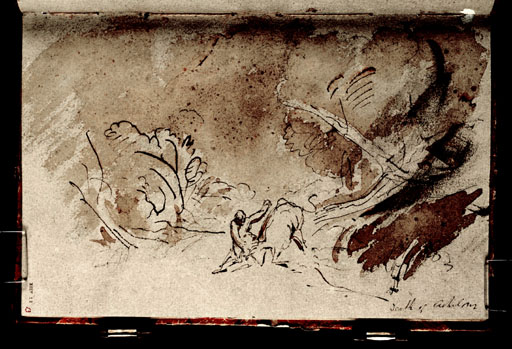Joseph Mallord William Turner The 'Death of Achelous' 1805
Image 1 of 2
Joseph Mallord William Turner,
The 'Death of Achelous'
1805
Joseph Mallord William Turner 1775–1851
Folio 13 Recto:
The ‘Death of Achelous’ 1805
D05865
Turner Bequest XCIV 13
Turner Bequest XCIV 13
Pen and ink and brown wash on white wove paper, prepared with a grey wash, 143 x 228 mm
Inscribed by Turner in ink ‘Death of Achelous’ bottom right
Inscribed by John Ruskin in red ink ‘13’ bottom left, descending vertically
Stamped in black ‘XCIV 13’ bottom left, descending vertically
Inscribed by Turner in ink ‘Death of Achelous’ bottom right
Inscribed by John Ruskin in red ink ‘13’ bottom left, descending vertically
Stamped in black ‘XCIV 13’ bottom left, descending vertically
Accepted by the nation as part of the Turner Bequest 1856
Exhibition history
1990
Painting and Poetry: Turner’s ‘Verse Book’ and his Work of 1804–1812, Tate Gallery, London, June–September 1990 (14).
References
1909
A.J. Finberg, A Complete Inventory of the Drawings of the Turner Bequest, London 1909, vol.I, p.244, XCIV 13, as ‘Study for a picture of “Death of Achelous”’.
1974
Gerald Wilkinson, The Sketches of Turner, R.A. 1802–20: Genius of the Romantic, London 1974, p.73 reproduced in colour.
1990
Kathleen Nicholson, Turner’s Classical Landscapes: Myth and Meaning, Princeton 1990, pp.154–5 reproduced fig.68.
1990
Andrew Wilton and Rosalind Mallord Turner, Painting and Poetry: Turner’s ‘Verse Book’ and his Work of 1804–1812, Tate Gallery, London 1990, pp.119 reproduced, 120.
1993
David Hill, Turner on the Thames: River Journeys in the Year 1805, New Haven and London 1993, p.166.
1997
Anthony Bailey, Standing in the Sun: A Life of J.M.W. Turner, London 1997, p.92.
The river god Achelous, in the form of a bull, is wrestled to the ground by Hercules, as described in Book 9 of Ovid’s Metamorphoses. Turner’s treatment of subjects from Ovid is discussed at length by Nicholson.1 This drawing is one of five in the sketchbook (the others being folios 14–17, D05866–D05869) illustrating the Metamorphoses. Their uniformly fluid execution in pen and wash and inscription with their titles suggests that Turner made them in one session, working from or close to his translation of the text; with the Death of Nessus and Death of Lycus [Lichas] on folios 14 and 15 this subject forms a sequence of episodes in the life of Hercules that follows the narrative in the poem (Book 9, 1–280). Rather than his brave exploits, these show the hero made vulnerable by his love for Deianera.
As Wilton observes, Turner’s title for this drawing does not accurately describe the moment depicted. In Ovid’s text, Hercules’s combat with Achelous, his rival for Deianera’s hand, falls into several parts. First, Achelous fights with him in the form of a man and is overcome, but then transforms himself, first into a snake and then into a bull when he is again brought down by Hercules who tears off one of his horns, as shown here. The detached horn then becomes the Cornucopia and Achelous turns back into a river once more.
Wilton notes that the introduction of myth into landscapes of riverside trees is typical of Turner’s work along the Thames while staying at Isleworth; see especially the Studies for Pictures: Isleworth sketchbook (Tate D05491–D05617; D40568–D40574; D41505; Turner Bequest XC). In Nicholson’s view, Turner has transferred the ‘physicality and exuberance’ of the combat of Hercules and Achelous to his rendering of the landscape.
Turner sketched a rough copy of Domenichino’s picture of the same subject in Paris in 1802 in his Studies in the Louvre sketchbook (Tate D04374; Turner Bequest LXXII 77).
Verso:
Blank, save for some splashes of ink or wash
David Blayney Brown
December 2007
How to cite
David Blayney Brown, ‘The ‘Death of Achelous’ 1805 by Joseph Mallord William Turner’, catalogue entry, December 2007, in David Blayney Brown (ed.), J.M.W. Turner: Sketchbooks, Drawings and Watercolours, Tate Research Publication, December 2012, https://www


